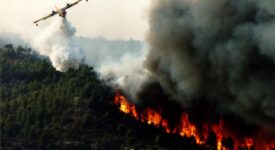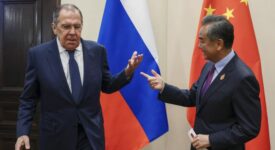In 2022 the world is more certain about the challenges it faces and more aware of its vulnerability and interdependence. The future is always uncertain, but today’s doubts are less about what and more about how, who and until when. The problem is not one of diagnosis. Data and conclusions abound about the importance of the present moment and the major transitions underway in the digital, green and labour fields. But the failure to carry them out collectively and inclusively leaves us in a fractured landscape. Key to the debate are the questions around where the point of no return lies, what kind of leadership is best equipped or has most legitimacy to pilot these transformations and how the process should be handled to ensure the social costs are as low as possible.
What will be special about 2022? The advancing vaccination programs should ensure that at some point this year – perhaps later than initially hoped – the damage can be counted and we can begin to look forward. One of the year’s major themes will therefore be the long-awaited recovery and everything that might frustrate it (prices, geopolitical tensions, bad news in the health sphere). In this process of post-pandemic restart, it will be clear that the world is not only advancing at different speeds, but that some groups will end up worse off than before, for example, in terms of mobility and humanitarian crises. One of the most frequently asked questions this year will be whether we have learned from the pandemic to face global challenges with greater anticipation, ambition and solidarity. This document is the result of the collective reflection of the CIDOB research team in collaboration with EsadeGeo.
ECONOMIC RECOVERY — The Covid-19 outbreak brought the economy to an unprecedented halt, with GDP dropping 4% globally in 2020 and over 10% in places such as Spain. Once the initial shock had passed, the production of a vaccine in record time and ambitious stimulus plans opened up a path towards recovery. The economic and social drama was eased by the measures implemented to support particularly vulnerable groups, expansionary fiscal and monetary policy and stimulus plans of varying magnitudes. In 2022 these measures will be evaluated and the duration of their implementation will be discussed, along with their financing. In 2022, the international economic debate will try to clear up five unknowns: the solidity and sustainability of the recovery in developed economies; the level of vulnerability of middle-income economies; the degree of disparity in the behavior of the so-called emerging economies; price rises and supply bottlenecks and blockages as matters of global concern; and, finally, the likelihood and potential impact of the Chinese bubble bursting (Evergrande). Even if these risks are avoided, the economic recovery agenda will face opposition; if the mentioned dangers materialize, that opposition will be all the greater.
GEOPOLITICAL TENSION — Great power tensions will set the global geopolitical pace and condition the prospects of recovery. The US–China relationship has become the international system’s structuring rivalry. Added to this is the risk of escalation in Ukraine, with the deployment at the end of 2021 of over 100,000 Russian troops at the border, and the US stating that any aggression would be met with a response. Along with these two great rivalries, tensions are resurfacing between states such as Algeria and Morocco, China and India and, to a lesser degree, Egypt and Ethiopia. When seeking to take the geopolitical temperature, many eyes also turn to Taiwan. In 2022 we should pay attention to how the rivalry reverberates in other arenas of competition, such as the South China Sea, the Korean peninsula, the opening up of Arctic routes and trade wars. The US will further strengthen its security commitment to Asia through the AUKUS alliance and new collaborations also with Delhi and Tokyo, breathing new life into the Quadrilateral Security Dialogue (QUAD). China, for its part, is promising a partnership of equals to African nations as part of its growing ambitions in this continent. The transatlantic connection will also be under the spotlight, especially during the NATO summit in June 2022 that will test the levels of convergence and trust between the US and its European allies and understand the alliance’s stance on China. Having embraced the ‘strategic autonomy’ principle, the EU will be forced to concentrate on matters in its neighborhood if tensions rise in Ukraine or Belarus or between Morocco and Algeria.
PRICES — Restarting the global productive and logistical machinery is proving more arduous than anticipated. Fears that the inflationary spiral and episodes of scarcity will compromise the economic recovery or call into question globalization as we have known it have catapulted this issue to the very top of the economic, political and social agendas. The price rises have more than one cause. In 2022 energy price rises will be among those with most geopolitical effect. For high-income countries, this will fundamentally translate into higher inflation, as higher energy prices impact all other products, even if only due to transport costs. For the companies and societies most involved in the planet’s sustainability a number of opportunities will arise. We should get an idea of the extent to which the combination of environmental awareness and supply problems consolidate different consumption patterns, a commitment to resize global value chains and provide a boost to the circular economy.
HEALTH — The spread of Covid-19 shot health to the top of the international agenda: there was the push for international cooperation on healthcare, the geopolitical use of the vaccine, and good or bad health management became a key ingredient of soft power. Success or failure on immunization, and the emergence or otherwise of effective Covid-19 treatments are decisive factors with a strong bearing on the political, economic and social agenda at all levels. 2021 ended with a new alarm over the appearance of the Omicron variant. The longer large pockets of the world’s population remain unvaccinated, the higher the chances of these situations are recurring. However in 2022 access to vaccines among the countries left behind in the vaccination drive should improve, in part because of the steady increase in production capacities not least in the EU and India. Africa is the main challenge since, with the exception of places like Morocco, Cape Verde and Tunisia, immunization levels remain below 10%. Countries in conflict merit special mention, because the issue is not only access to vaccines, but distribution problems and the critical state of their healthcare systems. There will also be greater pressure to reform international cooperation mechanisms such as the WHO, which proved to be indispensable yet insufficient.
FEARS — The fear of the pandemic has not disappeared, but it must share the stage with other fears. Some, like scarcity and supply chain disruption, are temporary. Others are more permanent in nature, like the consequences of climate change, social discontent and the obsolescence of certain types of training and jobs – according to a study by PWC 39% of employees believe that their job will be obsolete in five years’ time. This, in short, is the fear of being unable to adapt personally and collectively to a series of irreversible transformations. Meanwhile certain actors and interests feed and stoke fear, instrumentalize it politically, or take advantage of it economically. These practices and their effects on social cohesion will be clearly visible in 2022. If the fight against the pandemic is successful, 2022 could be a year of excitement, of turning the page. But even in that scenario the trauma of the health crisis will have left fertile ground for the politics and economy of fear, whereby especially the restrictive measures imposed by governments as a result of the pandemic will be subject to intense debate.
LEADERSHIPS — Who will allay the fears? Who will manage the climate, digital and social transitions? What kinds of ideas, people and models enjoy most support and legitimacy? We will learn more about these questions from two sources in 2022. First, citizens will give their opinion of the handling of the pandemic at elections. And, second, we will see which ideas, people and models generate the most credibility to drive the post-pandemic. It will not only be democratic leaders who seek to reestablish public trust this year; authoritarians will also invest efforts to consolidate their support bases and improve their international reputations. By a quirk of the electoral cycle, 2022 will see several markedly populist leaders facing re-election.
INNOVATIONS — Are we better prepared for a new way of doing things? Time will tell if the reassessment of the priorities of public administrations and societies that occurred in the pandemic has lasting effect. The measures imposed to tackle the health emergency accelerated processes of economic and social transformation. Readjustments may occur when it comes to teleworking, but the change of habits that has taken place in mobility, consumption and information processing and the intensive process of learning digital tools will be difficult to reverse. Another of the legacies of the health crisis has been the focus on science. Science budgets will be notably larger: the Next Generation EU funds allocate 37% and 20% to financing the green and digital transitions, respectively, while the US stimulus plans will spend $250 billion on innovation. On the other hand, this will exacerbate the concentration of scientific production in just a few countries (global investment in artificial intelligence (AI) and quantum computing is led mainly by the US and China). The environment is the second major field where efforts are being concentrated. In 2022, pressure will rise on scientific communities, businesses and public administrations to find innovative solutions to the climate crisis. In digital matters, chips will remain on the agenda.
MOBILITY — International mobility will be a significant factor in 2022, as the prospects of economic recovery, geopolitical tensions, the politics of fear and the polarization of the electoral debate in countries such as France, Hungary and the United States all contribute to placing it centre stage. This will materialize in five phenomena of varied nature. The first is that vaccination levels should mean that 2022 is the year of the great return to international travel. The second is that the measures imposed to contain the pandemic will increase the number of people looking to emigrate. The third factor is that the health crisis and the imbalances in restarting the economy have caused greater demand for workers in the main developed economies in sectors such as health and social care and transport, among others. Fourth, the World Cup in Qatar will place the spotlight on the rights and conditions of foreign workers. The fifth factor is the processes of emulation and learning in the political use of migration. Mobility will be a major issue around the world, but its importance will particularly increase in certain border areas (such as the Spain’s two autonomous cities, Ceuta and Melilla).
HUMANITARIAN CRISES — In 2020 and 2021, global humanitarian needs grew fast. According to the United Nations, between 2020 and 2021 the number of people in need of humanitarian aid rose from 167 to 235 million, whereby Covid-19 is acting as an aggravating factor for pre-existing humanitarian crises. One issue that could worsen an already complicated situation is the rapid and sustained rise in staple food prices. As 2022 approaches, warnings have been given that the food insecurity situation has reached “unprecedented catastrophic levels”. This short-term factor adds to long-term trends such as the re-emergence of frozen conflicts and the intensification of natural disasters and the destruction of habitats and livelihoods. Not only will there be more crises in 2022, they will also be addressed as more than just humanitarian problems. Their importance on the international agenda will become clear and in the discussion on what measures should be taken to alleviate them, geopolitical issues that transcend the humanitarian aspects will be considered in depth. Among other places, this will be the case in Afghanistan, East Africa and the Sahel, Central America and the Caribbean, Yemen and at Europe’s borders. When it comes to Afghanistan, the debate will principally surround what degree of recognition and dialogue should be granted to the Taliban. The humanitarian situations in several African countries will deteriorate in 2022. The humanitarian situation is also deteriorating in several areas of Central America and the Caribbean.
CLIMATE EMERGENCY — The Prime Minister of Barbados, Mia Amor Mottley, began her pointed speech at COP26 by recalling “that the pandemic has taught us that national solutions to global problems do not work”. What eventually emerged from the Glasgow summit was somewhat uneven. Politically, there were important gestures: the US returned to the table after Trump’s rebuffals; China signed a joint declaration of symbolic value with the US. However, last-minute pressure from India succeeded in watering down the final resolution on coal power. While the political leaders left Scotland with the peace of mind that at least an agreement was reached, climate activists were clearly disappointed. More combative sectors like, Extinction Rebellion that have announced mass mobilizations in April 2022. Those with more pragmatic positions, like the Race to Zero campaign, see the challenge for 2022 as expanding alliances and commitments. Another of the big themes for 2022 is the preparation of the carbon border adjustment mechanism (CBAM) and the reactions it provokes among those who feel it harms them. The EU is leading the way in this area, although debate will continue over the final form of the regulation in 2022. As to the policies to avoid the delocalization of polluting industries, their implementation will be gradual – starting in 2023 and being completed in 2026. In the first phase, it will affect large sectors such as the steel, fertilizer and cement industries. It will mean 2022 is a year in which the EU will have to do a lot of pedagogical work with countries that will accuse it of green protectionism, while also negotiating exemptions that do not invalidate the overall system. An early test will be the EU–African Union summit in February 2022.
‘The World in 2022: Ten Issues That Will Shape the International Agenda’ — Commentary by Eduard Soler i Lecha (coordinated and edited) — Barcelona Centre for International Affairs / CIDOB.







